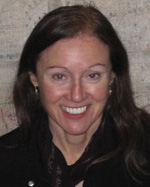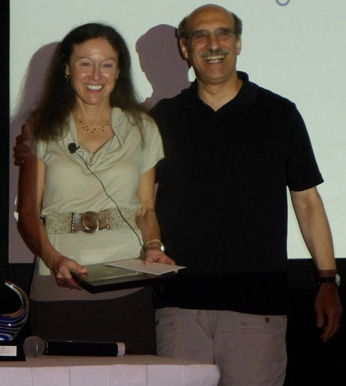Marianne Bronner Receives 2013
Conklin Medal
By Marsha E. Lucas
 Marianne
Bronner was awarded the 2013
Edwin G. Conklin Medal
for her distinguished and sustained research in
developmental biology and mentoring of the next
generation of scientists. Bronner has contributed
tremendously to our understanding of the biology of
the neural crest, from the timing of its induction
at the neural plate border, to the signals that
guide its migration pathways. She pioneered the use
of single cell injection to track the fates of
individual neural crest cells, establishing the
multipotency of individual crest cells. Her research
expanded into lamprey and amphioxus to uncover the
evolutionary origins of both the neural crest and
ectodermal placodes. Bronner's group has also been
integral in defining the gene regulatory network
that underlies neural crest development. Marianne
Bronner was awarded the 2013
Edwin G. Conklin Medal
for her distinguished and sustained research in
developmental biology and mentoring of the next
generation of scientists. Bronner has contributed
tremendously to our understanding of the biology of
the neural crest, from the timing of its induction
at the neural plate border, to the signals that
guide its migration pathways. She pioneered the use
of single cell injection to track the fates of
individual neural crest cells, establishing the
multipotency of individual crest cells. Her research
expanded into lamprey and amphioxus to uncover the
evolutionary origins of both the neural crest and
ectodermal placodes. Bronner's group has also been
integral in defining the gene regulatory network
that underlies neural crest development.
In a recent interview, she expressed how “thrilled”
she was to receive the Conklin Medal. “It means a
lot to me that it largely came from people who
trained with me as well as my colleagues. ... I'm
very honored by it—and a bit humbled by it as well.”
Bronner earned her doctorate in biophysics from
Johns Hopkins University in 1979. The following year
she started her first lab at the University of
California, Irvine. She spent 16 years there, rising
to become Associate Director of the Developmental
Biology Center before moving her lab to the
California Institute of Technology in 1996. She is
currently the Albert Billings Ruddock Chair of
Biology at Caltech.
Bronner has authored over 280 publications and
received numerous awards for her research, teaching,
and mentoring. In 2009 she was elected to the
American Academy of Arts and Sciences and in 2012 The
American Society for Cell Biology awarded her the
Women in Cell Biology Senior Award for her
outstanding scientific achievements and mentoring.
She has served the developmental biology community
as co-director of the
Embryology Course at the
Marine Biological Laboratory (1997-2001), SDB
President (2009), and is the current president of
the International Society for Differentiation.
Beyond the science, Bronner is well-respected for
her mentoring of students and postdocs. In their
nomination letters, Bronner's former trainees
repeatedly describe her as enthusiastic and
supportive.
She explained, “I try to get the best I can from
everybody by positive reinforcement.” She believes
people learn best “by being given a good positive
example and constructive criticism.”
“I take the greatest pleasure out of seeing the
people who study with me go on and do well,” she
said. “It is the most fun thing about this job.”
Remarkably, Bronner lacked good mentorship early on
in her career, as her graduate advisor left science
for a career in medicine. “There was nobody there
particularly taking good care of me, but there was
also nobody keeping me down,” she said. “So I guess
it forced me early on to be very independent and I
think that helped me to develop my own way of doing
things.”
Bronner found her role models elsewhere. “There were
not very many women, even in developmental biology,
at the time when I was a graduate student, and I
remember being incredibly struck by the work of
Nicole Le Douarin.”
Le Douarin, well-known for her work on the neural
crest, pioneered the
quail-chick chimera system to
study cell fates in the developing embryo. Bronner
first met Le Douarin (the 2005 Conklin Medal
recipient) when she gave a seminar at Johns Hopkins.
“I actually ended up emulating her and working on
the same topic and I think as a very strong woman in
science, she has continued throughout my career to
be somebody I've always looked up to. And so she's
probably the person who most shaped my career.”
Bronner was also supported by the late
Malcolm
Steinberg, a molecular biologist at Princeton
University where her parents worked. “I would visit
him when I was in graduate school and he sort of
took me under his wing, even though I wasn't his
student.” Steinberg provided guidance and
encouragement “out of the goodness of his heart,”
she said. “He had a major role in helping shape me
and I really appreciate that.”
|
 |
|
SDB President-elect, Martin Chalfie,
presented Bronner the 2013 Conklin Medal
at the 72nd Annual SDB Meeting in
Cancun, Mexico |
In her 30-year career, Bronner has put her stamp on
neural crest development research. It is difficult
for her to pinpoint which discovery is most
significant. “I always think the thing I'm working
on right now is the most interesting and
significant,” she said. That research happens to be
defining the regulatory interactions that generate a
neural crest cell.
“We have the tools to take a systems level approach
to studying the same questions we've been looking at
for decades now. And we know at a molecular level
what's going on in a specific cell type to make it
differentiate into one type of derivative versus
another at a level that we just didn't know before.
And that's really exciting. ...But, if you look back
at what's most cited, it's probably something I
published in the 1980s [laughter].”
Bronner is considered a model for work-life balance
by many of her trainees. She credits much of her
management skills to being a mother. “I learned how
to use small bits of time very efficiently and I
think that's served me really well,” she said.
In fact, she encourages this on-the-job training.
“I've convinced more than one postdoc that they
should have a baby."
Bronner reflected on how meaningful receiving the
Conklin Medal was for her, particularly from the
developmental biology community. “I've been a member
of the Society for Developmental Biology for almost
my entire career. I was honored to be elected
president in 2009 and I've worked so closely with so
many people in this field and I guess I feel like I
have reached the height of my career ... that I've
finally made it.”
|